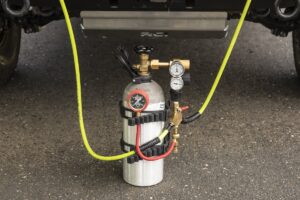Basic information about portable tanks
So a few words about portable tanks, cylinders filled with various types of gases.
Who among us has never seen a fire extinguisher indoors? A café, hospital, school, and even a bus - there is a device such as a fire extinguisher in practically every public place. Of course, in order for a fire extinguisher to be used for its intended purpose, its operability must be strictly controlled. Periodic tests organized by the Office of Technical Inspection serve this purpose. The fire extinguishing tanks are tested. Do you think you won't learn anything new from this article? And did you know that fire extinguishers up to 6 kg do not have to be inspected by the Office of Technical Inspection? It's not everything! Check out the blog post to learn more about pressure equipment, more specifically portable tanks.
What are portable tanks?
 "Within the meaning of these provisions, portable tanks are tanks that change their place in time between filling and emptying, and vehicle tanks (§ 2 p. 1)." This is an excerpt from the regulation of the Minister of Industry and Trade as well as the construction and technical condition of portable tanks for compressed, liquefied and dissolved gases under pressure. When looking for another explanation for this type of device, you can come across a definition that defines portable tanks as:
"Within the meaning of these provisions, portable tanks are tanks that change their place in time between filling and emptying, and vehicle tanks (§ 2 p. 1)." This is an excerpt from the regulation of the Minister of Industry and Trade as well as the construction and technical condition of portable tanks for compressed, liquefied and dissolved gases under pressure. When looking for another explanation for this type of device, you can come across a definition that defines portable tanks as:
- extinguishing tanks for the extinguishing agent,
- breathing apparatus cylinders,
- diving apparatus cylinders,
- special device tanks.
Special powers
In order to legally use portable tanks, their use must be reported to the competent authority. Interestingly, NOT EVERY portable tank is eligible for notification. So what is the relationship? The pressure vessel should be reported to the Office of the UDT or the UDT Branch in order to obtain a decision authorizing the operation, if:
V - capacity in dm3 (liters)
P - overpressure in bar - overpressure specified by the tank manufacturer or overpressure of the safety valve setting
Overpressure> 0.5 bar
You are not sure yet whether to report the operation of your portable tank to the UDT cell? Remember that the following tanks are not subject to technical inspection:
|
|
|
|
Periodic examinations
Due to the fact that some portable tanks are subject to UDT supervision, periodic tests are also becoming an important issue. These types of tests are a form of UDT supervision and, depending on the type of tank, take place at specific intervals. How does it work in practice? Periodic tests are carried out in the form of:
- internal inspections, and for pipelines as a main inspection;
- pressure tests,
- external audits.
What else do I need to know about periodic health check-ups? Periodic inspections are carried out on portable tanks marked with the inspector's mark of the Polish technical inspection authority or CE marked with a sticker affixed with the date of the next periodic inspection. Periodic tests are carried out by inspectors of the Office of Technical Inspection at the request of the operator or a representative acting on his behalf.


































